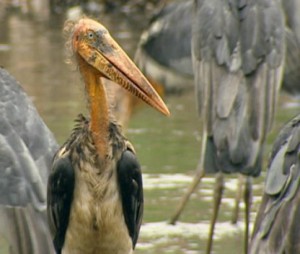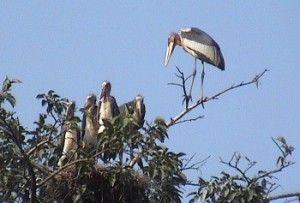 In pages of Indian mythology, the mythical bird Garuda has a pivotal role. Considered as the carrier of Lord Vishnu, this bird is said to have such large wingspan that it can shade the sun. But in the real world, the bird that is biologically known as the Greater Adjuntant and popularly called the Garuda is endangered. Now, Four years after these birds of the stork family started nesting and breeding in Bihar’s Bhagalpur district, their number has increased four-fold – from 78 to over 300.
In pages of Indian mythology, the mythical bird Garuda has a pivotal role. Considered as the carrier of Lord Vishnu, this bird is said to have such large wingspan that it can shade the sun. But in the real world, the bird that is biologically known as the Greater Adjuntant and popularly called the Garuda is endangered. Now, Four years after these birds of the stork family started nesting and breeding in Bihar’s Bhagalpur district, their number has increased four-fold – from 78 to over 300.
“A fourfold increase is not only a positive development but a matter of celebration,” said Arvind Mishra, coordinator in Bihar and Jharkhand for the Indian Birds Conservation Network who conducted a latest survey on the species. “In 2007, only 78 Garudas were counted in the district.”
According to Mishra it is all thanks to the conservation drive started in the locality by conservationists supported by the local villagers.
Loss of nesting habitat and feeding sites through drainage, pollution and disturbance, together with hunting and egg collection, caused a massive dip in the population of the species.
It was in 2007 when Mishra first spotted the bird nesting and breeding on a silk cotton tree near a village in the Ganga-Diara area in Bhagalpur. Earlier, the species had never been seen in Bihar during the breeding period.
“I was excited when I found the endangered Garuda breeding in the flood plains (Diara) of the Ganga and Kosi rivers in the district for the first time,” Mishra said.
The Garuda, biologically known as Greater Adjutant, is classified as endangered on the International Union for Conservation of Nature (IUCN) Red List 2004 of threatened species and listed under Schedule IV of the Indian Wildlife (Protection) Act, 1972.
The large wading bird belongs to the Leptoptilos dubius species.
“The birds are on the verge of extinction. Attempts are being made all over the world to conserve and save them,” said Mishra.
 The mythical history of the bird, in a way helped save it in its new home. Mishra says how villagers worshipped the tree as sacred and looked after the bird.
The mythical history of the bird, in a way helped save it in its new home. Mishra says how villagers worshipped the tree as sacred and looked after the bird.
Mandar Nature Club officials in Bhagalpur, working hard to create awareness among the locals on the need for protecting the birds, said villagers were proud that the Garuda birds had chosen this place for shelter and breeding.
“Bhagalpur is the third nesting region of this species in the world,” said Mishra, who has been working on a project supported by the Wildlife Trust of India for the protection of the species.“This could be a good sign for the survival of a good number of the species,” he added.
Earlier, the Greater Adjutant was found in South and Southeast Asia but now it breeds only in Assam and Bhagalpur in India, and in Cambodia.
The main threat they now face in Bihar is from the local nomadic Banpar tribes, which collect the eggs and chicks and hunt the birds for food.
Mishra also warns of the drug Diclofenac, a pain-killer used by farmers to treat cattle that is spelling doom to the vultures of India. He says that as the garuda too feed on dead animal carcasses, chances are that these birds too could be affected by the drug.
About the Greater Adjutant
The Adjutant is a huge stork. It has a naked pink head with a huge pink bill. It also has a low hanging head pouch. The bird looks like a vulture. Other than the pale grey edge on each wing, the rest of the Greater Adjutant’s body is dark grey.
Juveniles have a narrower bill, thicker down on the head and neck, and entirely dark wings. A Garuda bird measures 145-150 cm (about three feet) in length and four to five feet in height.
Related Stories:
Great Indian Bustard now Critically Endangered
Vulture Deaths Slowing Down Post Killer Drug Ban
Road through Rann may Ruin Flamingo Population
Reference: Hillpost










Thank you for the good news regarding the Greater Adjutant. Just returned from Assam (Guwahati to Kaziranga), saw many nesting Lesser Adjutants but not a single Greater one.
By the way, does anyone have experience with nesting boxes for Indian birds? Europe is full of them and they certainly help many tree-hole nesting species but is there a website where I can get some experience from Indian bird-lovers? I intend setting them up for woodpeckers, owls hornbills etc. in Goa.
Thank you Victor. Yes, it is great to know that the Greater Adjutant is making a comeback. Regarding your query for nesting boxes, sadly there are not many who would go about planting these in trees here in India. But I can suggest you get in touch with Mohammad Dilawar who is known for his exceptional work in saving house sparrows. He has invented simple nesting boxes for sparrows and allows people to adopt these too. Here is his site address http://www.natureforever.org/ and here is a story we did on World House Sparrow Day if you wish to know more about Dilawar.
Keep visitng and do share your photos of the Lesser Adjutant with us.